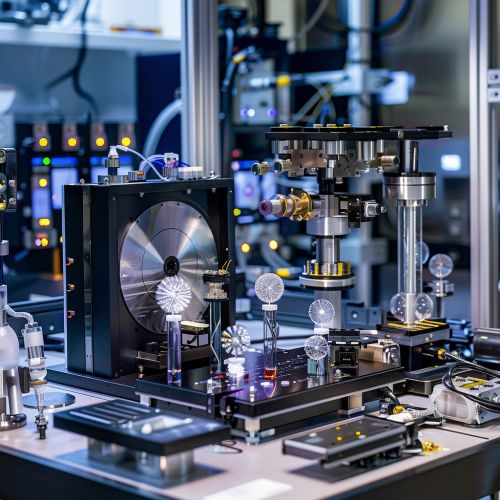Quantum Node: Difference between revisions
(Created page with "== Introduction == A '''Quantum Node''' is a fundamental element in quantum computing and quantum communication networks. It serves as a point in a quantum network where quantum information is processed, stored, or transmitted. Quantum nodes are essential for the realization of quantum internet, enabling the transmission of quantum states across long distances and facilitating complex quantum computations. == Quantum Computing and Quantum Nodes == Quantum co...") |
No edit summary |
||
| Line 21: | Line 21: | ||
One of the challenges in quantum communication is the loss of quantum information over long distances. Quantum repeaters are specialized quantum nodes that extend the range of quantum communication by entangling qubits over intermediate distances and performing [[quantum teleportation]]. | One of the challenges in quantum communication is the loss of quantum information over long distances. Quantum repeaters are specialized quantum nodes that extend the range of quantum communication by entangling qubits over intermediate distances and performing [[quantum teleportation]]. | ||
[[Image:Detail-96177.jpg|thumb|center|A quantum node setup in a laboratory environment with various quantum devices and optical components.]] | |||
== Quantum Node Implementation Technologies == | == Quantum Node Implementation Technologies == | ||
Revision as of 09:53, 4 July 2024
Introduction
A Quantum Node is a fundamental element in quantum computing and quantum communication networks. It serves as a point in a quantum network where quantum information is processed, stored, or transmitted. Quantum nodes are essential for the realization of quantum internet, enabling the transmission of quantum states across long distances and facilitating complex quantum computations.
Quantum Computing and Quantum Nodes
Quantum computing relies on the principles of quantum mechanics, particularly the phenomena of superposition and entanglement. A quantum node typically consists of qubits, which are the basic units of quantum information. Unlike classical bits, qubits can exist in multiple states simultaneously due to superposition, and they can be entangled with other qubits, allowing for instantaneous state correlations regardless of distance.
Structure and Functionality
Quantum nodes are composed of several key components:
- **Qubits**: These can be realized using various physical systems such as trapped ions, superconducting circuits, photons, or quantum dots.
- **Quantum Memory**: This is used to store quantum information. Quantum memories must maintain coherence over long periods to be effective.
- **Quantum Gates**: These are the operations that manipulate qubits. Quantum gates are the building blocks of quantum circuits.
- **Quantum Channels**: These are used for transmitting qubits between nodes. Quantum channels can be optical fibers or free-space links.
Quantum Communication Networks
Quantum nodes play a crucial role in quantum communication networks, which aim to achieve secure communication through quantum key distribution (QKD) and other protocols. These networks consist of multiple quantum nodes interconnected by quantum channels.
Quantum Key Distribution
QKD is a method for secure communication that uses quantum mechanics to ensure the security of cryptographic keys. Quantum nodes in a QKD network generate and distribute keys that are theoretically immune to eavesdropping.
Quantum Repeaters
One of the challenges in quantum communication is the loss of quantum information over long distances. Quantum repeaters are specialized quantum nodes that extend the range of quantum communication by entangling qubits over intermediate distances and performing quantum teleportation.

Quantum Node Implementation Technologies
Several technologies are being explored for implementing quantum nodes, each with its advantages and challenges.
Trapped Ions
Trapped ions are a leading technology for quantum nodes due to their long coherence times and high-fidelity quantum gates. Ions are trapped using electromagnetic fields and manipulated with lasers to perform quantum operations.
Superconducting Circuits
Superconducting circuits are another promising technology, particularly for their scalability and integration with existing semiconductor technologies. These circuits operate at cryogenic temperatures and use Josephson junctions to create qubits.
Photonic Systems
Photonic systems use light particles (photons) to represent qubits. They are advantageous for quantum communication due to their ability to travel long distances with minimal loss. Photonic quantum nodes often use nonlinear optical materials and integrated photonic circuits.
Challenges and Future Directions
Despite significant progress, several challenges remain in the development and deployment of quantum nodes.
Decoherence
Decoherence is the loss of quantum coherence due to interactions with the environment. It is a major obstacle in maintaining the integrity of quantum information over time.
Scalability
Scaling quantum nodes to create large-scale quantum networks is a complex task. It requires advances in both hardware and software to manage and control numerous qubits and quantum channels.
Error Correction
Quantum error correction is essential for reliable quantum computation and communication. Developing efficient error-correcting codes and fault-tolerant quantum gates is a critical area of research.
Applications
Quantum nodes have a wide range of potential applications beyond quantum communication and computing.
Quantum Metrology
Quantum nodes can be used in quantum metrology to achieve high-precision measurements. Quantum-enhanced sensors and clocks can provide unprecedented accuracy in various fields, including navigation and fundamental physics.
Quantum Simulation
Quantum nodes can simulate complex quantum systems that are intractable for classical computers. This capability is valuable for understanding materials, chemical reactions, and biological processes at the quantum level.
See Also
- Quantum Computing
- Quantum Communication
- Quantum Key Distribution
- Quantum Teleportation
- Quantum Metrology
- Quantum Simulation
